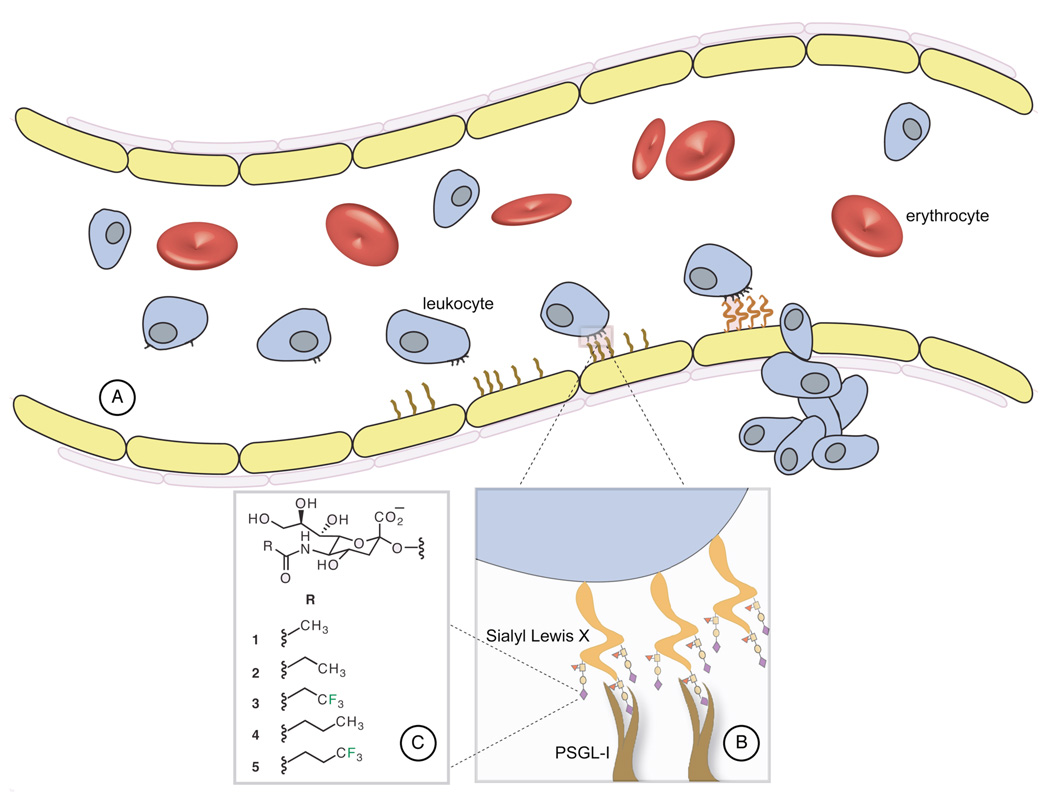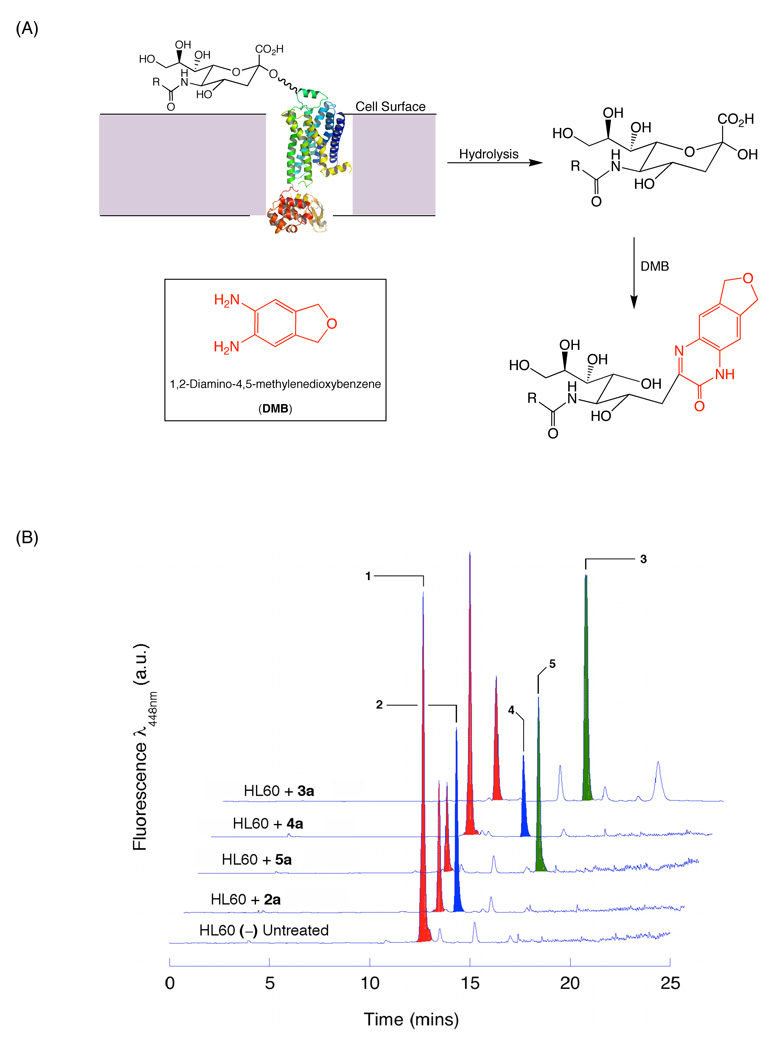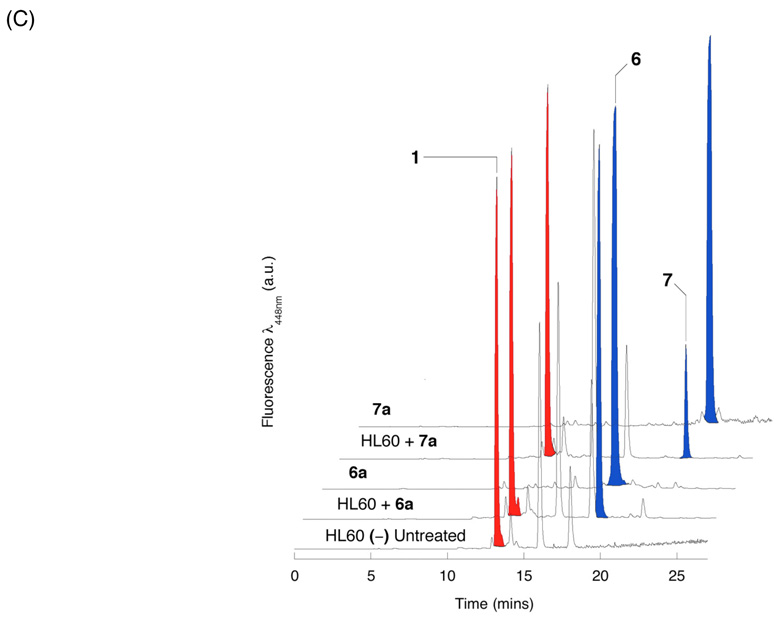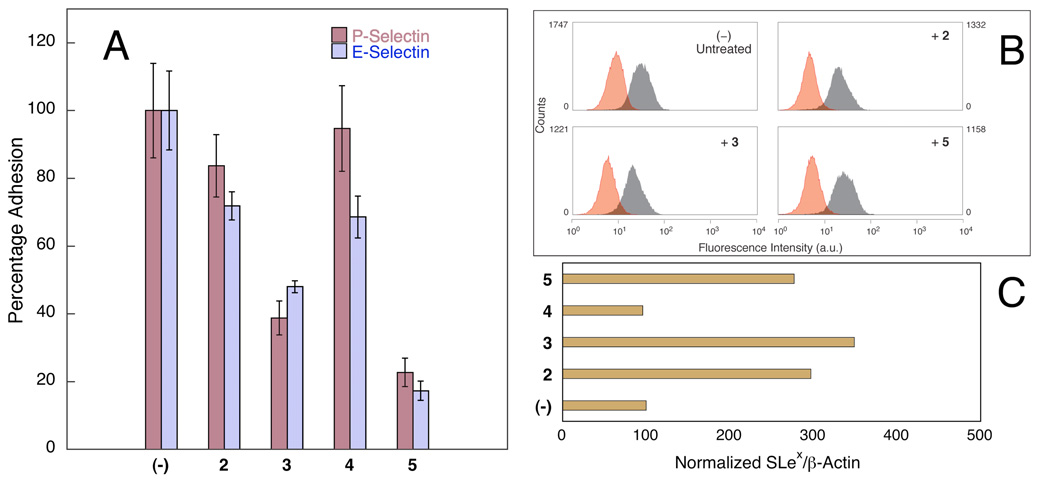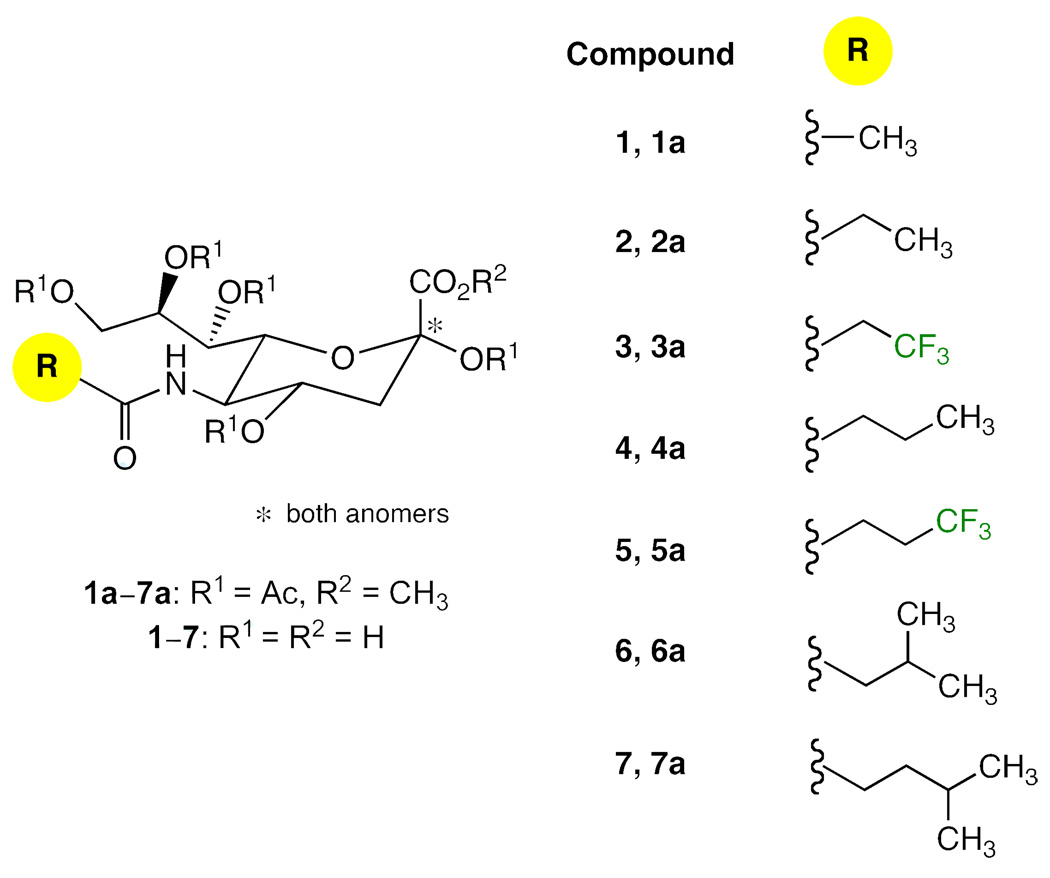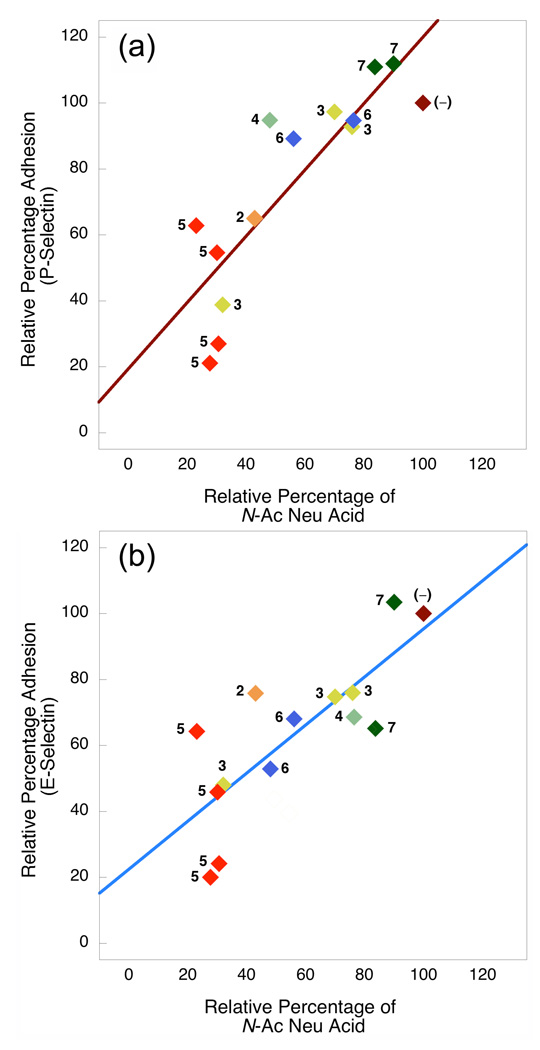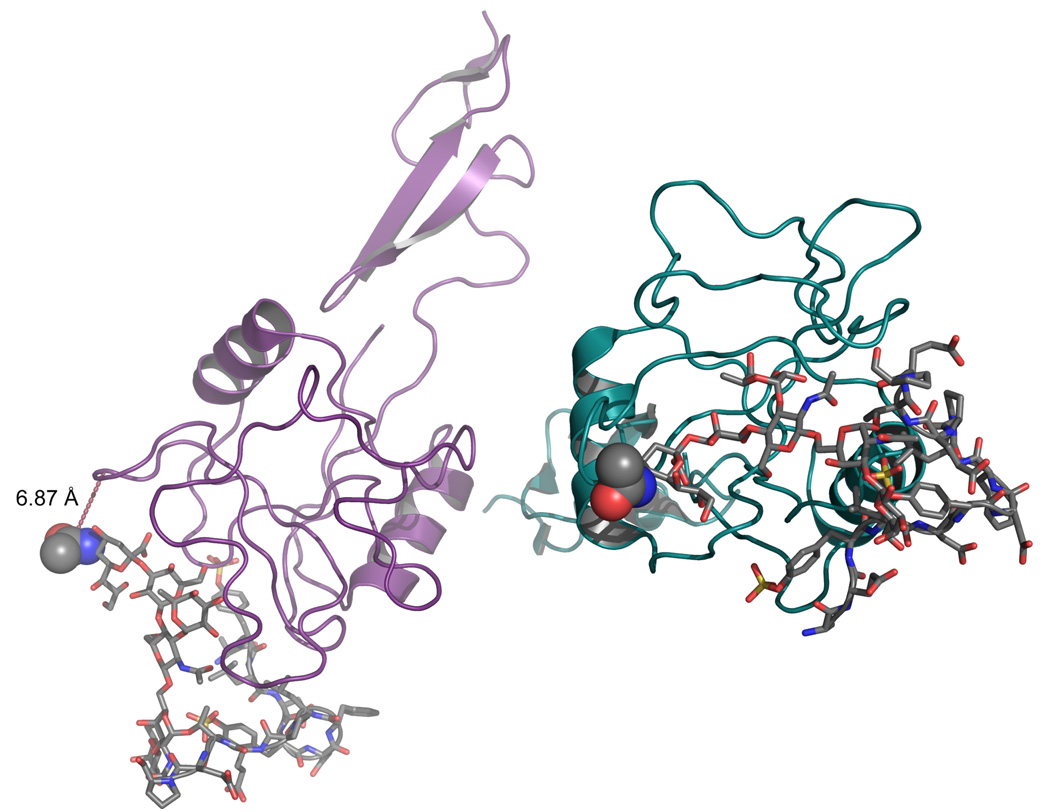Abstract
Aberrant glycosylation of lipid and protein molecules on cellular surfaces is responsible for many of the pathophysiological events in tumor progression and metastasis. Sialic acids in particular, are overexpressed on the glycocalyx of malignant tumor cells and sialic acid-mediated cell adhesion is required for metastasis. We report here that replacement of sialic acids on cell surfaces with fluorinated congeners dramatically decreases cell adhesion to E– and P–selectin-coated surfaces. Comparison of adhesion of fluorinated cells with those modified with non-fluorinated analogues suggests that both reduce binding of the modified sialosides to their cognate lectins to a similar extent on a per molecule basis. The overall reduction in cell adhesion results from greater cell surface presentation of the fluorinated congeners. This work suggests an avenue for inhibition of metastasis by administration of small molecules, and concomitant non-invasive imaging of tumor cells by 19F MRI before they are visible by other means.
Keywords: Glycoengineering, Cell Adhesion, Sialic Acid, Selectins, Fluorination
Introduction
The carbohydrates present on the surface of virtually every eukaryotic cell are responsible for mediating a wide range of interactions between the cell and its environment, ranging from recognition and signaling, to motility and adhesion. The growing appreciation of this central role for the cellular glycocalyx has led to major efforts in mapping differences in cell surface glycans among tissues, and between diseased and normal cells. These efforts have in turn led to carbohydrate-based or carbohydrate-targeted strategies for the detection, treatment, or prevention of a wide range of diseases, ranging from viral infection1 and malaria2 to cancer.3–5
Cancer progression is accompanied by changes in the glycans expressed on cell surfaces. Tumor cells display more sialic acids as part of the surface carbohydrates as their metastatic potential increases6, 7 and the overall level of tumor cell polysialylation is correlated with decreased survival time in cancer patients.8 The sialylated glycans on tumor cells resemble leukocyte glycans necessary for the process of extravasation during inflammation. It is thought that by expressing leukocyte-like sialylated glycans, a cancerous cell that has broken away from the primary tumor is able to escape the blood stream and form a metastatic tumor at a different site (Figure 1A). Members of two key protein families, the selectins and the integrins, mediate leukocyte rolling and firm adhesion – essential steps in extravasation.9–12 Sialyl Lewis X (SLeX) and A (SLeA), tetrasaccharide epitopes that bind to selectins (Figure 1B), are overexpressed on tumor cells and correlate with poor prognosis.13 For instance, a recent surgical note demonstrated that for cultured cells derived from primary (CHMp) and metastatic (CHMm) lesions of a canine mammary gland tumor from the same animal, adhesion to human umbilical vein endothelial cells that express activated E-selectin was dramatically enhanced in the case of CHMm cells.14 Similarly, expression levels of α2,3-linked sialic acid residues correlated with the metastatic potential of human gastric cancers.15 The α2–6 sialyltransferase enzyme (ST6Gal-I) is upregulated by oncogenes such as ras leading to dramatically increased α2–6 sialylation of the β1 subunit of integrins, and β1 from adenocarcinomas exhibits increased α2–6 sialylation relative to normal epithelial cells. ST6Gal-I expression in colon epithelial cells lacking endogenous ST6Gal-I manifests itself in enhanced adhesion to ECM proteins.16 Consequently, altering selectin- and integrin-mediated adhesion is an emerging strategy for diminishing the metastatic potential of tumor cells. We envisioned that modification of sialic acids on the glycocalyx with fluorinated groups (Figure 1C) would result in reduced cell adhesion, based on prior demonstrations of the bioorthogonal noncovalent behavior of highly fluorinated surfaces.17–20 Neelamegham and co-workers have recently shown that fluorination of GalNAc alters cell adhesion to selectins21 and we have reported that cell-surface fluorination leads to modest decrease in adhesion to fibronectin.22
Figure 1.
Hematogenous tumor metastasis mimics leukocyte extravasation. (A) Cell rolling and firm adhesion leading to extravasation are mediated by carbohydrate-protein interactions. (B) Rolling requires interaction of CD162-bound SLeX on the blood-borne cell with P-selectin on the vascular endothelium. (C) Inset showing the glycoengineered terminal carbohydrate on SLeX
Mammalian cells can be induced to display sialic acids possessing unnatural chemical moieties via a glycoengineering strategy. Pioneering work by Reutter and colleagues established that mannosamine derivatives bearing unnatural N-acyl groups (e.g. propanoyl) are processed by cells through the sialic acid biosynthetic pathway, leading to cell surface presentation of the foreign group on sialylated glycans.23, 24 Indeed, cells bearing propanoylated sialic acids exhibit increased adhesion to P– and E–selectin-coated surfaces due to an increase in the amount of SLeX presented on the cell surface protein PSGL-1,25 as well as increased adhesion to fibronectin-coated surfaces,26 establishing sialic acid glycoengineering as a fruitful strategy for altering cell adhesion. The field has been broadened by the discovery that sialic acid derivatives bearing extra-biological chemical functionalities are also taken up by cells and processed through this pathway27, and that the range of groups tolerated is larger when introduced on sialic acid than on the precursor mannosamine as it is downstream of the most stringent step – phosphorylation of mannosamine catalyzed by Man-6-kinase.27, 28 Sialic acid glycoengineering has been exploited to attach bioorthogonally reactive functional groups such as azide,28 ketone,28 and thiol29 to cell surfaces. This in turn has permitted highly selective decoration of cell-surface polysialic acid,30 and attachment of tailored immunogenic sialic acids to tumor-specific antigens.31 Cell surface modification has been demonstrated in living animals, including rat32 and mouse32–34 without apparent toxicity, raising the possibility that glycoengineering precursors may be useful for therapeutically altering cell adhesion.
Experimental Procedures
Cell Culture Conditions
HL60 cells were grown in RPMI-1640 medium supplemented with 10% FBS and penicillin–streptomycin (100 units/mL) in a 5% CO2, water saturated atmosphere at 37 ଌ. Cell densities were maintained between 2.0 × 105 and 2.0 × 106 cells/mL.
Detection of Sialic Acid Analogues on Cell Membranes by HPLC
HL60 cells were grown to cell densities of approximately 2 × 105 cells/mL in 12 mL of media. The cultures were supplemented with the appropriate volume of ethanolic solutions of the peracetylated methyl esters of compounds 2–5 (2a–5a) to give a final concentration of 200 µM, and the cells were incubated for 72 h. The cells were harvested, washed three times with PBS, and lysed by three freeze/thaw cycles. The membrane fraction was pelleted by centrifugation at 10,000 µ g for 15 min, and the pellet was washed twice with distilled water. After centrifugation at 10,000 µ g (15 min), the pellet was hydrolyzed for 3 h with 200 µL of 2 M AcOH at 80 °C. The supernatant was passed through 3,000 MW cut-off filters and the filtrate was concentrated. Sialic acid derivatization was performed according to the method of Hara et al.35 and samples were analyzed by reversed-phase HPLC on a C18 column [Tosoh G0005-02E C18 Reverse phase, 4.6 mm × 250 mm, 5μ] using a linear gradient of acetonitrile and water [Solvent A: 98:2 H2O:CH3CN; Solvent B: 99:1 CH3CN:H2O] at a flow rate 1.0 mL/min. The relative content of sialic acid analogue and NeuAc was quantified by integration of peak areas (Figures 3B and 3C).
Figure 3.
Analysis of fluorinated sialic acids on cell surfaces. (A) Schematic of the hydrolysis and labeling procedure. Modified cells were lysed (three freeze-thaw cycles), the membranes pelleted (10,000 × g), and subjected to acid hydrolysis (2M HOAc, 80 °C). The hydrolysate was passed through a 3000 Da cutoff molecular weight filter, and released sialic acids were derivatized by treatment with DMB according to literature procedures.35 (B) HPLC traces of the DMB-labeled cell membrane hydrolysates from cells used for E- and P-selectin cell adhesion assays. (C) HPLC traces of the DMB labeled cell membrane hydrolysates from cells treated with 6a and 7a used for E- and P-selectin cell adhesion assays. The numbered peaks correspond to the DMB derivatives of the compounds as confirmed by co-injection with standards.
Cell Lysate Preparation and Analysis using Antibody-conjugated Beads
Collected cells were suspended in lysis buffer at 4 °C for 30 min (CelLytic Protein Extraction Kit, Sigma). The cell lysate was cleared by microcentrifugation 30 min at 16,000 × g (maximum speed) at 4 °C. Tumble incubation of 30 µL of 50% protein A-Sepharose bead slurry with 5 µL of CD162 IgG (Beckman Coulter M2090) in PBS was carried out for 24 h at 4 °C and the beads were washed twice with lysis buffer. The cleared lysate was added to the antibody-coated beads and further incubated for 12 h at 4 °C while mixing end over end. Microcentrifugation and removal of the unbound proteins was performed for 10 s at 16,000 × g (maximum speed) at 4 °C. The beads were washed three times with ice-cold wash buffer and once with cold PBS. Protein concentrations were determined in 96 well ELISA plates using 100 µL bicinchonic acid protein reagent and 5 µL sample. The absorbance was measured using an InfiniteTM 200 series microplate reader (Tecan Group Ltd, Switzerland) at 562 nm.
Immunoblotting
Samples (20 µL/lane, 400 µg/lane) were separated on SDS polyacrylamide gels (4–20% Pierce) and transferred to nitrocellulose filters. Equal loading was confirmed by actin staining. The blots were blocked with 5% fat-free dry milk powder in Tween PBS, followed by incubation with the primary antibody anti-sialyl-Lewisx antibody KM93 (Millipore MAB2096) and then the appropriate secondary antibody conjugated with peroxidase (goat anti-mouse IgM polyclonal, Millipore AP128P). Chemiluminescence was measured on Kodak Biomax MS film for 30–45 min. The molecular weights were calculated based on MW marker standards.
Cell Adhesion Assays
Prior to the adhesion, 96-well plates were coated with P– or E–selectin (10 µg/mL) for 16 h at 4 °C. Unspecific binding was blocked with 1% BSA for 4 h at 4 °C. Cells were incubated for 72 h with 2a–5a at 37 °C. Collected cells were washed and incubated under serum-free medium for 2 h before the experiment. Cells were labeled with Calcein-AM at a final concentration of 12.5 µM for 30 min at 37 °C. Cells were washed three times with PBS, resuspended and then added to each well (1.5 × 105 cells in 100 µL) in quadruplicate. The plate was shaken at 611 rpm for 10 s and spun at 411 × g for 2 mins in order to move the cells to the plate surface, then incubated for 2 h at 37 °C. The "before-wash" fluorescence of the samples was measured using a fluorescence plate reader at excitation wavelength 485 nm and emission wavelength 520 nm. The non-adherent cells were gently aspirated and the wells were washed twice with 100 µL PBS. Finally, 100 µL PBS was added to each well and the "after-wash" fluorescence was measured. The percent adhesion was calculated using the formula: [(RFUafter-wash)/ [(RFUbefore-wash)] × 100. Individual experiments were performed in four to six replicates for each compound and a statistical Student’s t-test was applied. A typical experimental dataset is shown in the Supplemental Data (Table S1). A set of 3–4 such experiments was then normalized for percentage adhesion for each compound and the averages reported (Figure 4).
Figure 4.
Effect of cell surface fluorination on adhesion to P– and E–selectin. (A) Introduction on the cellular glycocalyx of fluorinated sialic acids 3 or 5, but not alkyl congeners 2 or 4, dramatically reduces the adhesion of cells to selectins. The compounds were fed to cells in the peracetylated, methyl ester forms (2a–5a, Figure 2) to facilitate passage across the plasma membrane. Error bars represent one S.D. (B) Flow cytometry analysis of modified and native cells with anti-SLex primary and FITC-labeled anti-IgG secondary antibody demonstrates no significant difference in cell surface SLeX amounts. (C) Western blot analysis of CD162-bound SLeX demonstrates that decreased adhesion to P–selectin is not due to reduced CD162; treated cells have the same or higher levels. See also Table S1 and Figure S2.
Flow Cytometry
Cell were seeded at 2.0 × 105 cells/mL and incubated for three days with compounds 2a–5a. Cells were collected and washed three times with PBS. Immunostaining was carried out by incubation with anti-sialyl-Lewisx antibody KM93 (Millipore MAB2096) at the optimal concentration (5 µg/1mL) in PBS supplemented with 1% BSA for 1 h at 4 °C. Cell surface binding was detected using the F(ab’)2 fragment of FITC-conjugated goat anti-mouse immunoglobulin (affinity-isolated antibody; Dako Cytomation F0479). Flow cytometry was performed on a MoFlo™instrument from Dako Cytomation. Cells were gated by forward and side scatter signals. A total of ~20,000 cells were analyzed in each experiment.
Chemical Synthesis of Sialic Acid Analogues
Compounds 1a–7a were synthesized using modified versions of literature procedures.27, 36 Purities of the compounds were judged to be ≥95% by HPLC on a reverse phase analytical column (J. T. Baker C18, 5 μ, 4 mm × 250 mm) using linear gradients composed of H2O and CH3CN. The anomeric ratios were calculated from relative NMR peak areas.
2,4,7,8,9-Penta-O-acetyl-5-N-trifluoropropanoyl-3,5-dideoxy-D-glycero-β-D-galacto-non-2-ulosonic-1-methyl ester (β–3a)
1H NMR (300 MHz, CDCl3) δ 6.03 (1H, d, J=9.01 Hz), 5.37 (1H dd, J=1.92 Hz, J=5.06 Hz), 5.33-5.27 (1H, m), 5.03–5.27 (1H, m), 4.51 (1H, dd, J=2.45 Hz, J=12.49 Hz ), 4.12–4.21 (3H, m), 3.79 (3H, s), 3.03-2.93 (2H, m), 2.56 (1H, dd, J=4.97 Hz, J=13.48 Hz ), 2.14-2.09 (7H, m), 2.06 (3H, s), 2.03 (3H, s), and 2.02 (3H, s); 13C NMR (75.5 MHz, CDCl3) δ 170.91, 170.74, 170.63, 170.41, 168.37, 166.39, 163.10, 124.31 (CF3, JC–f=276.98 Hz), 97.46, 72.49, 71.54, 67.81, 67.82, 62.09, 53.38, 49.621, 41.81 (CH2CF3, JC–F=29.62 Hz), 36.19, 21.02, 20.91, 20.87, 20.83, and 20.75; ESI-MS calcd for C23H30F3NNaO14 (M+Na+) 624.15, found: 624.18. ESI-HRMS calcd for C23H30F3NNaO14 (M+Na+) 624.1516, found: 624.1500. Ratio of anomers (%):α: β = 16:84
2,4,7,8,9-Penta-O-acetyl-5-N-trifluorobutanoyl-3,5-dideoxy-D-glycero-β-D-galacto-non-2-ulosonic-1-methyl ester (β–5a)
1H NMR (300 MHz, CDCl3) δ 5.79-5.76 (1H, d, J=8.6 Hz), 5.34 (1H, dd, J=1.82 Hz, J=5.00 Hz), 5.28-5.12 (1H, m), 5.05-5.01 (1H, m), 4.47 (1H, dd, J=2.51 Hz, J=12.4 Hz), 4.14-4.10 (3H, m), 3.76 (3H, s), 2.57-2.48 (3H, m), 2.30 (2H, m), 2.12 (3H, s), 2.10-2.06 (4H, m), 2.03 (3H, s), 2.01 (3H, s), and 1.97 (3H, s); 13C NMR (75.5 MHz, CDCl3) δ 171.05, 170.71, 170.44, 170.35, 170.22, 168.35, 166.40, 126.80 (CF3, JC–F=276.98 Hz), 97.50, 72.72, 71.41, 68.24, 67.79, 62,11, 53.31, 49.42, 36.07, 28.92, 20.97, 20.93, 20.88, 20.85, 20.82 and 17.66; ESI-MS calcd for C24H32F3NNaO14 (M+Na+) 638.17, found: 638.17. ESI-HRMS calcd for C24H32F3NNaO14 (M+Na+) 638.1673, found: 638.1653. Ratio of anomers:α:β (%) = 32:68
2,4,7,8,9-Penta-O-acetyl-5-N-3-methylbutanoyl-3,5-dideoxy-D-glycero-β-D-galacto-non-2-ulosonic-1-methyl ester (β–6a)
1H NMR (300 MHz, CDCl3) δ 5.37-5.33 (4H, m), 5.12-5.08 (1H, m), 4.51 (1H, d, J=10.76 Hz), 4.21-4.08 (4H, m), 3.82 (3H, s), 2.59 (1H, dd, J=5.34 Hz, J=13.20 Hz ), 2.19 (3H, s), 2.13 (3H, s), 2.09 (3H, s), 2.06 (3H, s), 2.05 (3H, s), 1.95-1.89 (2H, m), and 0.96 (6H, m); 13C NMR (75.5 MHz, CDCl3) δ 173.04, 171.26, 171.06, 170.76, 170.67, 168.73, 166.84, 97.88, 73.29, 71.82, 68.52, 68.31, 62.80, 53.65, 49.59, 46.45, 36.39, 30.15, 26.20, 22.78, 22.72, 21.41, 211.34, 21.29, and 21.23; ESI-MS calcd for C25H37NNaO14 (M+Na+) 598.56, found: 598.27. ESI-HRMS calcd for C25H37NNaO14 (M+Na)+ 598.2112, found: 598.2103. Ratio of anomers (%):α:β = 46:54
2,4,7,8,9-Penta-O-acetyl-5-N-4-methylpentanoyl-3,5-dideoxy-D-glycero-β-D-galacto-non-2-ulosonic-1-methyl ester (β–7a)
1H NMR (300 MHz, CDCl3) δ 5.45 (1H, d, J=8.08 Hz), 5.34 (2H, d, J=5.08), 5.19-5.15 (1H, m), 5.07-5.05 (1H, m), 4.48 (1H, dd, J=1.41 Hz, J=13.2 Hz), 4.17-4.08 (3H, m), 3.78 (3H, s), 2.54 (1H, dd, J=4.80 Hz, J=13.17 Hz), 2.17 (3H, s), 2.14 (3H, s), 2.05 (3H, s), 2.03 (3H, s), 2.01 (3H, s), 1.56-1.41 (4H, m), and 0.871 (6H, d, J=6.29 Hz); 13C NMR (75.5 MHz, CDCl3) δ 171.80, 171.25, 171.10, 170.06, 170.67, 168.53, 166.80, 97.58, 73.72, 71.94, 68.80, 67.71, 62.79, 54.05, 49.59, 35.79, 34.71, 30.15, 27.10, 22.80, 22.67, 20.91, 21.30, 21.19, 21.01, and 20.88; ESI-MS calcd for C26H39NNaO14 (M+Na+) 612.24, found: 612.36. ESI-HRMS calcd for C26H40NNaO14 (M+H+) 590.2449, found: 590.2452. Ratio of anomers (%):α:β = 37:63
Results and Discussion
Incorporation of Unnatural Sialic Acids
In the current study, our goal was to use sialic acid to fluorinate the glycocalyx and thereby reduce selectin-mediated cell adhesion. Accordingly, to modify their surfaces, HL60 cells (human promyelocytic leukemia) were incubated with unnatural sialic acids 2a–5a (Figure 2) that bear pendant groups on the 5-position. After three days of culture, the membrane fractions of the cells were collected. The extent of incorporation of the unnatural sialic acid was determined by acid hydrolysis and labeling with the α-keto acid-specific fluorogenic reagent 1,2-diamino-4,5-methylene-dioxybenzene (DMB)35 (Figure 3A). All derivatives were incorporated with reasonable efficiencies, with modified sialic acids 2–5 comprising 57%, 68%, 24%, and 71% of the total sialic acid on the cell surface. Based on the estimation of the amount of all sialic acids present, in the case of 3 and 5, there were ~108 CF3 groups on the surface of each cell (Table 1). This is consistent with prior studies where under saturating conditions of mannosamine-derived precursors, ~2·106 unnatural N-acyl sialic acids were incorporated on Jurkat cells and >107 on HL60 cells.37 Approximating the cross-sectional surface area of a CF3 group to be 25 Å2, an estimate of the fractional fluorinated cellular surface area that an apposing adhesion partner would encounter can be made. Dustin and co-workers have determined the total surface area of a Jurkat cell to be ~800 µm2.38 If 3 × 107 trifluoromethyl groups are displayed per cell, the fractional surface area of the cell occupied by CF3 groups is 0.9%
Figure 2.
Structures of sialic acid derivatives used for incubation with mammalian cells in this study. Compounds were fed to the cells in the pentaacetyl methyl ester form (1a–7a). Presumably these are converted by intracellular lipases to the free hydroxyl (and acid) forms (1–7) before they enter the biosynthetic pathway. Material isolated from cell surfaces was in the "free" form.
Table 1.
Incorporation of modified sialic acids on HL60 cells treated with compounds 2a–7a.
| Treatment compound |
N-Ac-Neu acid |
Modified sialic acid |
Total sialic acid (% modified) |
No. of CF3 groups/cell |
|---|---|---|---|---|
| none | 1.00 | – | 1.00 (−) | – |
| 2a | 0.52 | 0.68 | 1.20 (57) | – |
| 3a | 0.29 | 0.62 | 0.91 (68) | 4.5 × 107 |
| 4a | 0.84 | 0.26 | 1.09 (24) | – |
| 5a | 0.35 | 0.89 | 1.24 (72) | 6.8 × 107 |
| 6a | 1.04 | 0.12 | 1.15 (10) | – |
| 7a | 0.78 | 0.61 | 1.40 (44) | – |
Values are normalized to N-acetylneuraminic acid in untreated cells.
Calculated number of CF3 groups based on total sialic acid as determined by the DMB labeling standard curve (Supplementary Figure S1).
The relative amounts were determined by DMB-labeling, integrated areas in HPLC, and the cell count.
Adhesion to ECM Proteins
The ability of the fluorinated sialic acids to alter cellular adhesion to ECM proteins and selectins was assessed by incubating cells with peracetylated methyl esters 2a–5a at 200 µM concentrations for 3 d. The cells were pelleted, washed with buffer, counted, and a known number of cells resuspended in buffer. They were further labeled with the live cell-specific fluorescent dye, Calcein-AM. The cells were then transferred to wells in microtiter plates coated with E– or P–selectin (Figure 4A) and allowed to adhere for 2 h at 37 °C. The fluorescence emanating from the wells was measured at this stage. The wells were then washed with buffer and the fluorescence was measured once again. The fluorescence before and after washing revealed the number of cells adhered to proteins immobilized on plates. The most dramatic difference in adhesion was observed for P–selectin where cells treated with 3a and 5a were 62% and 77% less adherent than untreated cells. Remarkably, cells treated with 2a showed the same extent of adhesion as those treated with 1a.25 A single CH3 to CF3 modification on the sialic acid thus had a dramatic effect on the adhesive properties of the cell. The fluorinated derivatives resulted in decreased adhesion to all three of the protein ligands.
The size of a trifluoromethyl group has often been compared to that of an isopropyl moiety. The most compelling evidence for this estimation comes from measurements of rotational barriers in 1,1’-disubstituted biphenyls along the biphenyl axis and the results are suggestive of a −CF3 group imposing steric restrictions equivalent to those of a −CH(CH3)2 group.39–41 In order to assess whether the size of the pendant group at the 5-position of neuraminic acid is the key determinant of decreased adhesion, compounds 6a and 7a were used as controls for 3a and 5. Cells treated with 6a and 7a exhibited adhesion to both P- and E-selectin-coated plates to an extent intermediate between untreated cells and those treated with 3a or 5a, but 6a and 7a were also incorporated less well (10% and 44%, respectively, see Figure 3C, and Table I).
The amount of SLeX presented specifically on P-selectin glycoprotein ligand-1 (PSGL-1, CD162) and generally on the cell surface was measured by Western blotting and flow cytometry analysis (Figures 4B,C). Assuming that the primary antibody specific for SLeX binds with the same affinity to the unnatural epitopes, no significant difference was evident in the amount of SLeX on cells treated with 2a, 3a, and 5a. Furthermore, CD162-SLeX levels on cells treated with 2a–5a were either the same, or significantly elevated.
Mechanism of Reduced Cell Adhesion
We have demonstrated that treatment of HL60 cells with fluorinated sialic acid analogues 3a and 5a leads to a significant reduction in the ability of these cells to adhere to E- and P-selectin compared with both untreated cells and with cells treated with unfluorinated congeners 2a and 4a (Figure 4A). There are at least three possible explanations for the larger reduction in adhesion by the fluorinated analogues: 1) the fluorinated sialosides, including sialyl Lewis X, exhibit specifically reduced binding on the molecular level with their cognate selectins; 2) the amount of the SLeX-presenting selectin binding partners (e.g. CD162 (PSGL-1) in the case of P-selectin) on the cell surface is reduced compared with untreated cells or cells treated with non-fluorinated sialic acids; and 3) the incorporation of fluorinated analogues on the cell-surface sialosides is enhanced compared to unfluorinated congeners.
To distinguish these possibilities, we measured the ratio of sialic acid analogues to natural N-Ac neuraminic acid present on the cell surface siaolsides using HPLC analysis of DMB derivatives35 (Figure 3B) as well as the total sialic acid content on the cell surfaces by comparison of fluorescence of the DMB-modified cell hydrolysates with a standard curve (See Supplemental Data, Figure S1). Modified sialic acids 2–5 were incorporated to the extent that they comprised 57%, 68%, 24%, and 71% of the total sialic acid on the cell surface, and total sialic acid content on cells treated with 2a-5a varied from 91%–124% of that on untreated cells (Table 1).
Previous work has shown incorporation of 2 on cell surface sialosides was accompanied by an increase in cell adhesion to P-selectin for cells treated with N-propanoyl mannosamine.25 In that study, the increased adhesion was found to accompany enhanced expression of CD162-SLeX (PSGL-1), the principal SLeX–bearing glycoprotein partner for P-selectin on the cell surface. To determine if the diminished adhesion we observed in cells treated with modified sialic acids 2a-5a was due to a decrease in CD162-SLeX expression, we measured the amount of CD162-SLeX on cell surfaces by both Western blot analysis (Figure 4C) and flow cytometry using antibodies specific for CD162 and for SLeX (Figure 4B). The data show that CD162-SLeX expression was the same (4a) or higher (2a, 3a, and 5a) than in untreated cells. Therefore, the reduction in cell adhesion that we observe is not due to reduced CD162-SLeX expression (see also Figure S2).
To distinguish the effect of the increased steric demand of fluorinated analogues 3a and 5a from the electronic effects of fluorination, we prepared N-isopropanoyl (6a) and N-isobutanoyl (7a) analogues of sialic acid and evaluated their effect on HL60 cell adhesion to P- and E- selectin. The data (Table I and Figure 3C) show that incorporation of these analogues is lower (10% for 6a and 44% for 7a) than for the fluorinated analogues and that cells treated with these analogues showed less diminution of adhesion to P- and E-selectin than cells treated with the fluorinated analogues.
Since the diminution in P-selectin adhesion is not due to a decrease in the cell-surface presentation of its cognate ligand CD162-SLeX, the simplest explanation of the observed reduction in cell adhesion upon surface modification (including fluorination) is that glycans bearing unnatural sialic acids are weaker binders of the selectins and other ECM receptor molecules.42 The extent to which N-Ac neuraminic acid is replaced by the unnatural sialic acids correlates reasonably with diminished adhesion, irrespective of the size (Figure 5). The larger the percentage of the unnatural sialic acid on the surface, the lower the adhesion. Fluorinated sialic acids, especially 5a, are incorporated more efficiently compared to the control molecules, and result in dramatically diminished adhesion.
Figure 5.
Plots showing relative percentage of N-Ac neuraminic acid (NANA) versus relative percentage adhesion (A) to P– and (B) E–Selectins (R values of 0.86 and 0.79 respectively) from individual experiments conducted in replicates of 5. The relative percentage of NANA ((NANA)/(NANA+unnatural) × 100) on the surface cell correlates with adhesion. The range of total sialic acid (NANA + unnatural derivative) in all experiments spanned 3.48 × 107 molecules/cell (low) to 1.29 × 108 molecules/cell (high).
The molecular basis for the observation that changes in the N-acyl group of the sialic acid residue in cell surface sialosides result in reduced binding to P-selectin is difficult to ascertain. A published crystallographic analysis11 of the CD162-SLeX:P-selectin complex reveals a distance of 6.87 Å between the acyl carbonyl and the nearest protein loop (Figure 6) and does not indicate an obvious steric conflict between the selectin and the N-acyl group. However, published structural data of the bound and free forms of SLex suggest that the Neu5Acα2–3Gal linkage resembles the free-form conformation "A" (ϕ,ψ = −43°,−12°) when complexed with E-selectin, but is not the global energy minimum.11, 43 It follows that subtle conformational changes in modified cell-surface CD162-SLeX structures with larger sialic acid N-acyl groups are likely to alter the energy of the optimal binding conformation thereby diminishing the binding affinity.
Figure 6.
Cartoon depiction of P-selectin EGF (LE) domain complexed with the N-terminal domain of CD162 modified by tyrosine sulfation and SLex. The acetyl chain at N5 of sialic acid is shown in space filling representation; PDB ID: 1G1S. 11 The nearest neighbor distance from the carbonyl carbon of the acyl (acetyl in this instance) group to any atom in the protein is 6.87 Å (MacPyMOL, Version 0.99, DeLano Scientific, San Carlos, CA). Although the acyl chain in the crystal structure does not seem to play a role in the interaction of P-selectin and SLex, conformational changes in SLeX are possible upon acylation with unnatural acids, leading to diminished binding.43, 45
Conclusion and Outlook
The results described here proffer a new method for a major alteration of the cell glycocalyx with no observed toxicity under cell culture conditions. The introduction of fluorinated groups on cell surfaces resulted in a significant decrease in cell adhesion to ECM receptor molecules and selectins, a property that is thought to be essential for tumor metastasis. This diminished adhesion is in general due to increased efficiency of incorporation, especially that of 5a, and depletion of the level of N-acetyl neuranamic acid on cell surfaces. Furthermore, since fluorine is scarce in soft tissue and cancerous cells are often hypersialylated, cell-surface fluorination may prove valuable for background-free 19F magnetic resonance imaging (MRI) before invasive tumors are visible by other means. The detailed mechanism by which altered adhesion is achieved is the subject of current investigation in our laboratories.
Supplementary Material
Acknowledgment
We thank D. Jefferson, S. Kwok and D. Lee of the Tufts Medical Center’s GRASP center, D. Walt, D. Kaplan and D. Lee (Tufts University) for the use of their tissue culture facilities, and C. Zamora and D. Yüksel for help with HRMS. HL60 cells were a kind gift from R. Horstkorte (Martin-Luther-Universität Halle-Wittenberg, Halle).44 This work was supported by the NIH (CA125033) and by E. I. DuPont de Nemours & Co. The ESI–MS and NMR facilities at Tufts are supported by the NSF (0320783 and 0821508). This paper is dedicated to Prof. M. Reza Ghadiri (Scripps Research Institute) on the occasion of his 50th birthday.
Abbreviations
- BSA
bovine serum albumin
- DMB
1,2-diamino-4,5-methylenedioxybenzene
- ECM
extra cellular matrix
- ELISA
enzyme-linked immunosorbent assay
- PBS
phosphate buffered saline
- PSGL-1
P-selectin glycoprotein ligand-1
- SDS
sodium dodecyl sulfate
- SLeA
sialyl Lewis A
- SLeX
sialyl Lewis X
- ST6Gal-I
α2-6 sialyltransferase enzyme.
Footnotes
Supporting Information Available: Typical data set for adhesion, standard curve for DMB labeling and Western blot to quantify SLeX. This material is available via the Internet at http://pubs.acs.org/.
References
- 1.Stevens J, Blixt O, Paulson JC, Wilson IA. Glycan microarray technologies: tools to survey host specificity of influenza viruses. Nat. Rev. Microbiol. 2006;4:857–864. doi: 10.1038/nrmicro1530. [DOI] [PMC free article] [PubMed] [Google Scholar]
- 2.Schofield L, Hewitt MC, Evans K, Siomos MA, Seeberger PH. Synthetic GPI as a candidate anti-toxic vaccine in a model of malaria. Nature. 2002;418:785–789. doi: 10.1038/nature00937. [DOI] [PubMed] [Google Scholar]
- 3.Buskas T, Ingale S, Boons GJ. Towards a fully synthetic carbohydrate-based anticancer vaccine: Synthesis and immunological evaluation of a lipidated glycopeptide containing the tumor-associated Tn antigen. Angew. Chem., Int. Ed. 2005;44:5985–5988. doi: 10.1002/anie.200501818. [DOI] [PubMed] [Google Scholar]
- 4.Warren JD, Geng XD, Danishefsky SJ. Glycopeptides and Glycoproteins: Synthesis, Structure, and Application. Vol. 267. 2007. Synthetic glycopeptide-based vaccines; pp. 109–141. [Google Scholar]
- 5.Galonic DP, Gin DY. Chemical glycosylation in the synthesis of glycoconjugate antitumour vaccines. Nature. 2007;446:1000–1007. doi: 10.1038/nature05813. [DOI] [PMC free article] [PubMed] [Google Scholar]
- 6.Yogeeswaran G, Salk PL. Metastatic Potential Is Positively Correlated with Cell- Surface Sialylation of Cultured Murine Tumor-Cell Lines. Science. 1981;212:1514–1516. doi: 10.1126/science.7233237. [DOI] [PubMed] [Google Scholar]
- 7.Pearlstein E, Salk PL, Yogeeswaran G, Karpatkin S. Metastatic Potential Correlates with Cell-Surface Platelet-Aggregation Potential and Cell-Surface Sialic-Acid of 10 Variant Pw20 Wistar-Furth Renal Sarcoma Cell-Lines. Clin. Res. 1980;28:A420–A420. [Google Scholar]
- 8.Fuster MM, Esko JD. The sweet and sour of cancer: Glycans as novel therapeutic targets. Nat. Rev. Cancer. 2005;5:526–542. doi: 10.1038/nrc1649. [DOI] [PubMed] [Google Scholar]
- 9.Alon R, Hammer DA, Springer TA. Lifetime of the P-Selectin-Carbohydrate Bond and Its Response to Tensile Force in Hydrodynamic Flow. Nature. 1995;374:539–542. doi: 10.1038/374539a0. [DOI] [PubMed] [Google Scholar]
- 10.Finger EB, Puri KD, Alon R, Lawrence MB, vonAndrian UH, Springer TA. Adhesion through L-selectin requires a threshold hydrodynamic shear. Nature. 1996;379:266–269. doi: 10.1038/379266a0. [DOI] [PubMed] [Google Scholar]
- 11.Somers WS, Tang J, Shaw GD, Camphausen RT. Insights into the molecular basis of leukocyte tethering and rolling revealed by structures of P- and E-selectin bound to SLe(X) and PSGL-1. Cell. 2000;103:467–479. doi: 10.1016/s0092-8674(00)00138-0. [DOI] [PubMed] [Google Scholar]
- 12.Xiao T, Takagi J, Coller BS, Wang JH, Springer TA. Structural basis for allostery in integrins and binding to fibrinogen-mimetic therapeutics. Nature. 2004;432:59–67. doi: 10.1038/nature02976. [DOI] [PMC free article] [PubMed] [Google Scholar]
- 13.Varki A. Glycosylation changes in cancer. In: Varki A, Cummings RD, Esko JD, Freeze HH, Hart GW, Marth JD, editors. Essentials of Glycobiology. Cold Spring Harbor (NY): Cold Spring Harbor Laboratory; 1999. pp. 537–549. [Google Scholar]
- 14.Nakagawa T, Endo Y, Watanabe M, Mochizuki M, Nishimura R, Sugano S, Sasaki N. Adhesional Function of Canine Mammary Gland Tumor Cells Expressing Sialyl Lewis X. J. Vet. Med. Sci. 2009;71:1225–1228. doi: 10.1292/jvms.71.1225. [DOI] [PubMed] [Google Scholar]
- 15.Wang FL, Cui SX, Sun LP, Qu XJ, Xie YY, Zhou L, Mu YL, Tang W, Wang YS. High expression of alpha 2, 3-linked sialic acid residues is associated with the metastatic potential of human gastric cancer. Cancer Detect. Prev. 2009;32:437–443. doi: 10.1016/j.cdp.2009.01.001. [DOI] [PubMed] [Google Scholar]
- 16.Seales EC, Jurado GA, Brunson BA, Wakefield JK, Frost AR, Beilis SL. Hypersialylation of beta(1) integrins, observed in colon adenocarcinoma, may contribute to cancer progression by up-regulating cell motility. Cancer Res. 2005;65:4645–4652. doi: 10.1158/0008-5472.CAN-04-3117. [DOI] [PubMed] [Google Scholar]
- 17.Bilgiçer B, Kumar K. De novo design of defined helical bundles in membrane environments. Proc. Natl. Acad. Sci. U. S. A. 2004;101:15324–15329. doi: 10.1073/pnas.0403314101. [DOI] [PMC free article] [PubMed] [Google Scholar]
- 18.Bilgiçer B, Xing X, Kumar K. Programmed self-sorting of coiled coils with leucine and hexafluoroleucine cores. J. Am. Chem. Soc. 2001;123:11815–11816. doi: 10.1021/ja016767o. [DOI] [PubMed] [Google Scholar]
- 19.Yoder NC, Kumar K. Fluorinated amino acids in protein design and engineering. Chem. Soc. Rev. 2002;31:335–341. doi: 10.1039/b201097f. [DOI] [PubMed] [Google Scholar]
- 20.Yoder NC, Yuksel D, Dafik L, Kumar K. Bioorthogonal noncovalent chemistry: fluorous phases in chemical biology. Curr. Opin. Chem. Biol. 2006;10:576–583. doi: 10.1016/j.cbpa.2006.10.007. [DOI] [PubMed] [Google Scholar]
- 21.Marathe DD, Buffone A, Chandrasekaran EV, Xue J, Locke RD, Nasirikenari M, Lau JTY, Matta KL, Neelamegham S. Fluorinated per-acetylated GalNAc metabolically alters glycan structures on leukocyte PSGL-1 and reduces cell binding to selectins. Blood. 2010;115:1303–1312. doi: 10.1182/blood-2009-07-231480. [DOI] [PMC free article] [PubMed] [Google Scholar]
- 22.Dafik L, d'Alarcao M, Kumar K. Fluorination of mammalian cell surfaces via the sialic acid biosynthetic pathway. Bioorg. Med. Chem. Lett. 2008;18:5945–5947. doi: 10.1016/j.bmcl.2008.09.010. [DOI] [PMC free article] [PubMed] [Google Scholar]
- 23.Kayser H, Ats C, Lehmann J, Reutter W. New amino sugar analogs are incorporated at different rates into glycoproteins of mouse organs. Experientia. 1993;49:885–887. doi: 10.1007/BF01952603. [DOI] [PubMed] [Google Scholar]
- 24.Mantey LR, Keppler OT, Pawlita M, Reutter W, Hinderlich S. Efficient biochemical engineering of cellular sialic acids using an unphysiological sialic acid precursor in cells lacking UDP-N-acetylglucosamine 2-epimerase. FEBS Lett. 2001;503:80–84. doi: 10.1016/s0014-5793(01)02701-6. [DOI] [PubMed] [Google Scholar]
- 25.Horstkorte M, Rau K, Reutter W, Nohring S, Lucka L. Increased expression of the selectin ligand sialyl-Lewis(x) by biochemical engineering of sialic acids. Exp. Cell Res. 2004;295:549–554. doi: 10.1016/j.yexcr.2004.01.016. [DOI] [PubMed] [Google Scholar]
- 26.Villavicencio-Lorini P, Laabs S, Danker K, Reutter W, Horstkorte R. Biochemical engineering of the acyl side chain of sialic acids stimulates integrin-dependent adhesion of HL60 cells to fibronectin. J. Mol. Med. 2002;80:671–677. doi: 10.1007/s00109-002-0382-y. [DOI] [PubMed] [Google Scholar]
- 27.Oetke C, Brossmer R, Mantey LR, Hinderlich S, Isecke R, Reutter W, Keppler OT, Pawlita M. Versatile biosynthetic engineering of sialic acid in living cells using synthetic sialic acid analogues. J. Biol. Chem. 2002;277:6688–6695. doi: 10.1074/jbc.M109973200. [DOI] [PubMed] [Google Scholar]
- 28.Luchansky SJ, Goon S, Bertozzi CR. Expanding the diversity of unnatural cell-surface sialic acids. ChemBioChem. 2004;5:371–374. doi: 10.1002/cbic.200300789. [DOI] [PubMed] [Google Scholar]
- 29.Sampathkumar SG, Li AV, Jones MB, Sun ZH, Yarema KJ. Metabolic installation of thiols into sialic acid modulates adhesion and stem cell biology. Nat. Chem. Biol. 2006;2:149–152. doi: 10.1038/nchembio770. [DOI] [PubMed] [Google Scholar]
- 30.Pon RA, Biggs NJ, Jennings HJ. Polysialic acid bioengineering of neuronal cells by N-acyl sialic acid precursor treatment. Glycobiology. 2007;17:249–260. doi: 10.1093/glycob/cwl075. [DOI] [PubMed] [Google Scholar]
- 31.Chefalo P, Pan YB, Nagy N, Guo ZW, Harding CV. Efficient metabolic engineering, of GM3 on tumor cells by N-phenylacetyl-D-mannosamine. Biochemistry. 2006;45:3733–3739. doi: 10.1021/bi052161r. [DOI] [PMC free article] [PubMed] [Google Scholar]
- 32.Kayser H, Zeitler R, Kannicht C, Grunow D, Nuck R, Reutter W. Biosynthesis of a nonphysiological sialic-acid in different rat organs, using n-propanoyl-d-hexosamines as precursors. J. Biol. Chem. 1992;267:16934–16938. [PubMed] [Google Scholar]
- 33.Gagiannis D, Gossrau R, Reutter W, Zimmermann-Kordmann M, Horstkorte R. Engineering the sialic acid in organs of mice using N-propanoylmannosamine. Biochim. Biophys. Acta, Gen. Subj. 2007;1770:297–306. doi: 10.1016/j.bbagen.2006.09.023. [DOI] [PubMed] [Google Scholar]
- 34.Prescher JA, Dube DH, Bertozzi CR. Chemical remodelling of cell surfaces in living animals. Nature. 2004;430:873–877. doi: 10.1038/nature02791. [DOI] [PubMed] [Google Scholar]
- 35.Hara S, Takemori Y, Yamaguchi M, Nakamura M, Ohkura Y. Fluorometric High-Performance Liquid-Chromatography of N-Acetylneuraminic and N-Glycolylneuraminic Acids and Its Application to Their Microdetermination in Human and Animal Sera, Glycoproteins, and Glycolipids. Anal. Biochem. 1987;164:138–145. doi: 10.1016/0003-2697(87)90377-0. [DOI] [PubMed] [Google Scholar]
- 36.Goon S, Schilling B, Tullius MV, Gibson BW, Bertozzi CR. Metabolic incorporation of unnatural sialic acids into Haemophilus ducreyi lipooligosaccharides. Proc. Natl. Acad. Sci. U. S. A. 2003;100:3089–3094. doi: 10.1073/pnas.0437851100. [DOI] [PMC free article] [PubMed] [Google Scholar]
- 37.Yarema KJ, Mahal LK, Bruehl RE, Rodriguez EC, Bertozzi CR. Metabolic delivery of ketone groups to sialic acid residues - Application to cell surface glycoform engineering. J. Biol. Chem. 1998;273:31168–31179. doi: 10.1074/jbc.273.47.31168. [DOI] [PubMed] [Google Scholar]
- 38.Dustin ML, Golan DE, Zhu DM, Miller JM, Meier W, Davies EA, van der Merwe PA. Low affinity interaction of human or rat T cell adhesion molecule CD2 with its ligand aligns adhering membranes to achieve high physiological affinity. J. Biol. Chem. 1997;272:30889–30898. doi: 10.1074/jbc.272.49.30889. [DOI] [PubMed] [Google Scholar]
- 39.Bott G, Field LD, Sternhell S. Steric Effects - a Study of a Rationally Designed System. J. Am. Chem. Soc. 1980;102:5618–5626. [Google Scholar]
- 40.Della EW. Conformational Preference of Trifluoromethyl Group. Tetrahedron Lett. 1966:3347–3351. [Google Scholar]
- 41.Nagai T, Nishioka G, Koyama M, Ando A, Miki T, Kumadaki I. The Steric Effect of a Trifluoromethyl Group. Chem. Pharm. Bull. 1991;39:233–235. [Google Scholar]
- 42.Perez-Castells J, Hernandez-Gay JJ, Denton RW, Tony KA, Mootoo DR, Jimenez-Barbero J. The conformational behaviour and P-selectin inhibition of fluorinecontaining sialyl LeX glycomimetics. Org. Biomol. Chem. 2007;5:1087–1092. doi: 10.1039/b615752a. [DOI] [PubMed] [Google Scholar]
- 43.Harris R, Kiddle GR, Field RA, Milton MJ, Ernst B, Magnani JL, Homans SW. Stable-isotope-assisted NMR studies on C-13-enriched sialyl Lewis(x) in solution and bound to E-selectin. J. Am. Chem. Soc. 1999;121:2546–2551. [Google Scholar]
- 44.The HL60 clone used in this study is hypersialylated and was a generous gift from R. Horstkorte (Berlin).
- 45.Poppe L, Brown GS, Philo JS, Nikrad PV, Shah BH. Conformation of sLe(x) tetrasaccharide, free in solution and bound to E-, P-, and L-selectin. J. Am. Chem. Soc. 1997;119:1727–1736. [Google Scholar]
Associated Data
This section collects any data citations, data availability statements, or supplementary materials included in this article.



